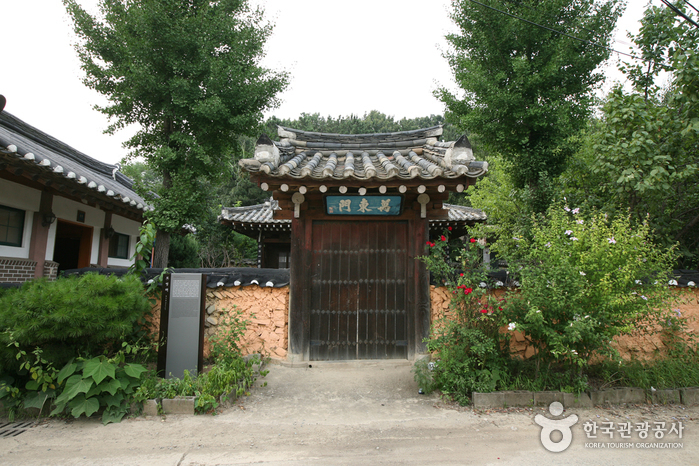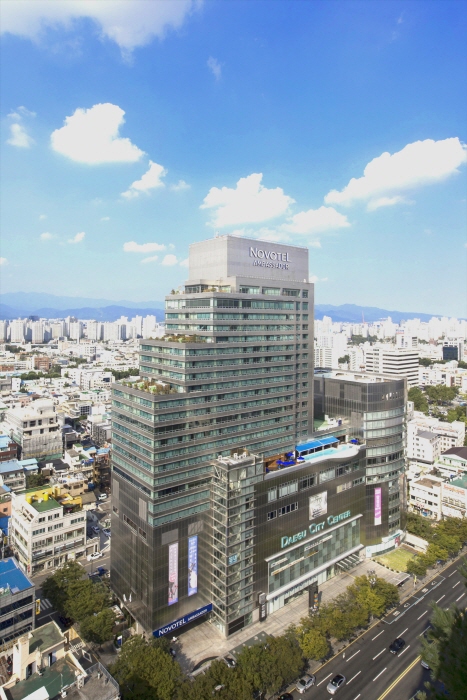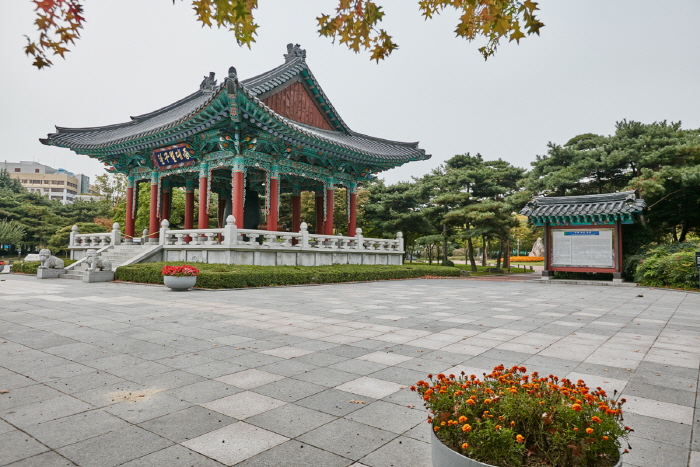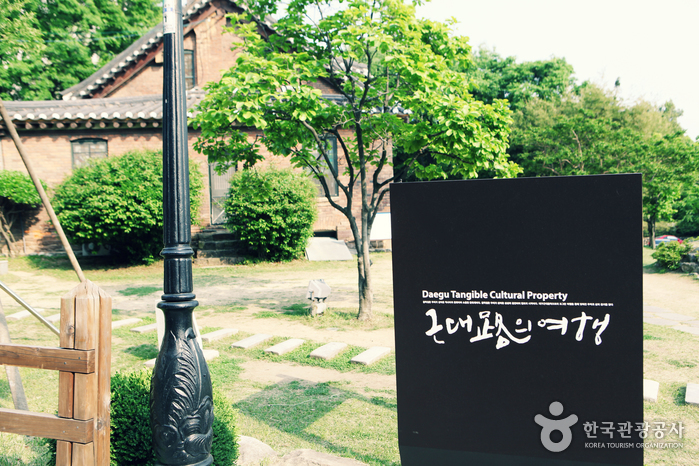Korean Traditional Culture Center (한국전통문화체험관)
15.3Km 2024-12-13
13-5 Dalgubeol-daero 527-gil, Suseong-gu, Daegu
+82-53-666-4930
Momyeongjae is an ancestral shrine built by the Dureung Doo clan to honor Doo Sa-chung, who had joined the Ming Dynasty's reinforcement troops during the Imjinwaeran (Japanese invasion of Korea, 1592) and later became naturalized in Joseon Dynasty. The name 'Momyeongjae' means 'longing for the Ming Dynasty,' expressing Doo Sa-chung's affection for his home country.
Doo Sa-chung, who was from Duling, China, went to Joseon under the command of General Li Rusong from the Ming Dynasty. Doo Sa-chung took the position titled Suryuk Jihoek Jusa and was responsible for selecting locations to establish a stronghold in consideration of the terrain. As a senior adviser to Li Rusong, he closely discussed strategies and tactics with the Joseon army as well.
When the war was over, Doo Sa-chung returned to China but went to Joseon again during the Jeongyujaeran (Japanese invasion of Korea, 1597). He brought his two sons -- Doo San and Doo Il-geon -- along with his brother-in-law, Admiral Chen Lin. When the war was over, Doo Sa-chung and his two sons naturalized in Joseon. The government of Joseon granted him land, which is the current Gyeongsang Gamyeong Park area.
When the Gyeongsang Gamyeong (Gyeongsang provincial office) was relocated to this area, Doo Sa-chung offered his land to the government and moved to Gyesan-dong.
Longing for his wife and brothers he had left in China, he moved again to a village near Daedeoksan Mountain (then Choejeongsan Mountain) and named the area Daemyeong-dong (meaning the Great Ming). He built a platform and on the first day of every month, he would bow in the direction of the Forbidden City in China, where the Emperor of the Ming Dynasty resided.
Momyeongjae is built on a rectangular plot and faces south. It features a hip-and-gable roof with double-layer eaves and has four rooms in the front and two rooms on the side. The daecheongmaru (wooden floor hall) has two ondol (floor heated) rooms on each of its side, with a half-sized bay at the front. Momyeongjae exemplifies the early 20th-century ancestral shrine style commonly found in the Daegu area.
The building was originally constructed in 1912 when Doo Sa-chung’s descendants moved wooden materials from the dismantled Gyeongsangaeksa (local government building) and used them to build Momyeongjae in front of Doo Sa-chung's tomb. The shrine was later renovated in 1966 as it was in poor condition.
Momyeongjae is one of the first destinations visited by Chinese tourists in Daegu. It was recently renovated as part of a redevelopment project. The Korean Traditional Culture Center opened nearby, where visitors can experience tea ceremonies, hanbok (traditional Korean clothing), archery, and cooking dishes based on Donguibogam, a traditional Korean medical encyclopedia. Joining a program at the center will be a valuable experience.
Novotel Ambassador Daegu (노보텔 앰배서더 대구)
15.3Km 2021-02-10
611, Gukchaebosang-ro, Jung-gu, Daegu
+82-53-664-1101
Novotel Ambassador Daegu opened in July 2008, offering top-quality service. The hotel is located in the center of Daegu’s finance, shopping, and culture district, and is connected to the subway station. Transportation from and to the train station and airport is extremely convenient, making it the perfect place for travelers to enjoy their leisure time. The hotel boasts luxurious guestrooms, a business center, upscale restaurants and bars, meeting rooms, and a fitness center and sauna, as well as an outdoor swimming pool.
National Debt Redemption Movement Memorial Park (국채보상운동기념공원)
15.3Km 2021-08-25
670, Gukchaebosang-ro, Jung-gu, Daegu
+82-53-745-6753
Construction on the National Debt Redemption Movement Memorial Park began in March 1998 and was completed in December 1999. The park was established to retain the spirit of the National Debt Redemption Movement that originated in Daegu in 1907 and the 2nd movement in 1997 that was held to help overcome the national economic distress affected by the Asian Financial Crisis of 1997. The park also expanded the green space in the downtown area and offers a place of rest and relaxation to the general public.
Spanning 42,500 square meters in size, the park boasts the Dalgubeol Grand Bell, a bell pavilion, walking trails, and other amenities. The famous Dalgubeol Grand Bell was installed on the park grounds in December 1998 as a representation of harmony and prosperity and to symbolically awaken the people with its pure and clear ringing. In addition the convenient and beautifule amenities, the park also has several memorial plaques engraved with quotes from many significant historical figures who shaped Korea's culture and values.
Arc'teryx [Tax Refund Shop] (ARCTERYX)
15.4Km 2024-06-26
132, Gyeongsanggamyeong-gil, Jung-gu, Daegu
-
Daegu Goods - Daegu Branch [Tax Refund Shop] (대구굿즈 대구)
15.4Km 2024-04-19
1F, 69, Seoseong-ro 14-gil, Jung-gu, Daegu
-
Olive Young - Dongseongro Branch [Tax Refund Shop] (올리브영 대구동성로)
15.4Km 2024-04-22
593, Gukchaebosang-ro, Jung-gu, Daegu
-
See Channel Eyewear - Daegu Dongseong-ro Branch [Tax Refund Shop] (씨채널한일로안경 대구동성로)
15.4Km 2024-04-19
604, Gukchaebosang-ro, Jung-gu, Daegu
-
Daegu Modern History Streets (Tour of Modern Streets) (대구 근대골목(근대로의 여행))
15.5Km 2023-10-27
66, Gukchaebosang-ro 102-gil, Jung-gu, Daegu
+82-53-661-3327
Daegu Modern History Streets is an experiential tour that brings the participants across Daegu’s alleyways and living history. During the Korean War, Daegu was much less damaged than other regions. Because of that, the city retains the changes in lifestyles before and after the war relatively well.
There are 13 courses in total, run by regional self-governance groups in Daegu, defined according to different themes and areas. The most popular among them is Course 2, the Modern Cultural Street, which takes visitors on a tour of major sites associated with Daegu’s modernity. Follow the retro aesthetics and the history of Daegu and Korea along places like Kyesan Catholic Church, Jeil Church, old houses, and the former Chinese Elementary School.
Note that multilingual tours are offered to international visitors in English, Japanese, and Chinese, in regular tours (14:00 every Saturday) and on-demand tours (available for groups of more than 5). Reservations are offered on the official website.

![Seobong Shoes [Tax Refund Shop] (서봉제화)](http://tong.visitkorea.or.kr/cms/resource/67/2883967_image2_1.jpg)



![Olive Young - Dongseongro Branch [Tax Refund Shop] (올리브영 대구동성로)](http://tong.visitkorea.or.kr/cms/resource/37/2883937_image2_1.jpg)
![See Channel Eyewear - Daegu Dongseong-ro Branch [Tax Refund Shop] (씨채널한일로안경 대구동성로)](http://tong.visitkorea.or.kr/cms/resource/54/2884054_image2_1.jpg)

 English
English
 한국어
한국어 日本語
日本語 中文(简体)
中文(简体) Deutsch
Deutsch Français
Français Español
Español Русский
Русский